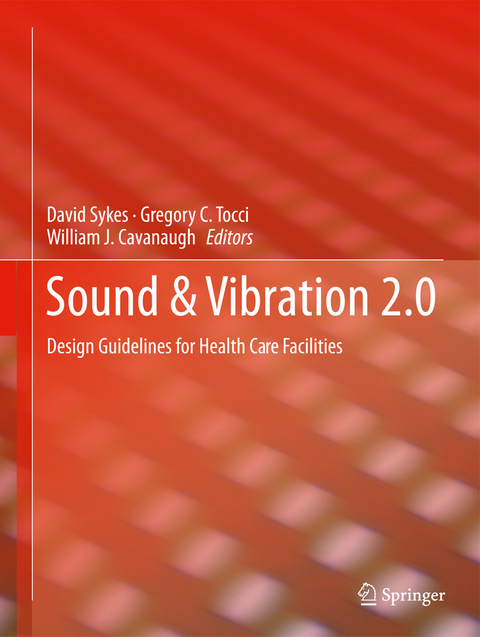Sound & Vibration 2.0
Springer-Verlag New York Inc.
978-1-4614-4986-7 (ISBN)
Sound and vibration are topics of increasing prominence in the design, construction, and operation of healthcare facilities. A satisfactory acoustical environment in a healthcare facility is now viewed as an essential component of effective healthcare.
Sensible acoustical and privacy planning in the early design stages of a healthcare facility project can be solved effectively and affordably with a few strokes of the designer's pencil. The recommended minimum design requirements presented in this work are therefore intended to aid designers in achieving satisfactory acoustical and privacy environments in healthcare facilities. This handbook includes comprehensive, practical, and measureable guidelines for all aspects of acoustics in the design, construction, and evaluation of all types of healthcare facilities, including large general hospitals, specialized patient carefacilities, and ambulatory patient care facilities.
David Sykes, ASA, INCE is Executive Chair of ARC llc; Co-chair of ANSI S12 WG44; Delegation leader to the 2011 national summit on alarm fatigue; Professor, Rensselaer Polytechnic Institute (RPI); Co-director of LARA, the Laboratory for Advanced Research on Acoustics at RPI; and Special Advisor to the Royal Scientific Society of Jordan. Sykes organizes and ARC hosts the FGI Acoustics Working Group, a 520-member trans-disciplinary committee responsible for authoring the comprehensive acoustical guidelines for the Facility Guidelines Institute, the Green Guide for Health Care, LEED for Health Care, The International Green Building Code, the U.S. General Services Administration and other groups. ARC also publishes the sole reference standard for the publications cited above, called “Sound & Vibration Guidelines for Health Care Facilities.” Mr. Sykes has organized and secured funding for several research and development projects on acoustics, privacy and healthcare at Harvard Medical School and other institutions and has been published in two books from MIT Press.
Note to Readers:.- Table of Contents.- Introduction.- Process Overview & Acknowledgements.- Development Timeline.- 1 Site Exterior Noise.- 1.1 General.- 1.2 Applicable Federal, State, and Local Codes and Regulations.- 1.3 Classification of non-facility produced exterior noise exposure.- 1.3.1 Exterior noise classifications.- A1.3 Procedure for determining composite sound transmission class rating (STCc) .- 1.4 Classification of facility produced exterior noise exposure.- 1.4.1 Heliports.- 1.4.2 Emergency power generators.- 1.4.3 Outdoor mechanical equipment.- 1.4.4 Building services.- 2 Acoustical Finishes and Details.- 2.1 General.- 2.2 Applicable Federal, State and Local Codes and Regulations.- 2.3 Design Criteria for Acoustical Finishes.- A2.3 Determination of Design Room Average Sound Absorption Coefficient ( design) and Room Sound Absorption Factors (AR, sf).- 2.4 Considerations for NICUs (from Standard 21: Ceiling Finishes).- A2.4.2 Interpretation:.- 3 Room Noise Levels.- 3.1 General.- 3.2 Federal, State and Local Codes, Regulations, and Guidelines.- 3.3 Design Criteria for Room Noise Levels.- 3.4 Conformance measurements of room sound level.- A3.4.1 Determination of Room Noise Level.- A3.4.2 Effect of Background Noise on Clinical Hearing Ability.- A3.4.3 Discussion of Background Noise Rating Criteria.- 3.5 Considerations for NICUs (from Standard 23: Acoustic Environment) .- A3.5.1 Interpretation:.- A3.5.2 Interpretation:.- 4 Sound Isolation Performance of Constructions.- 4.1 General.- 4.2 Applicable Federal, State and Local Codes and Regulation.- 4.3 Design guidelines for sound isolation between enclosed rooms.- A4.3.1 Typical partitions.- A4.3.2 Extraordinary partitions.- A4.3.3 Composite Sound Transmission Class (STCc).- 4.4 Design guidelines for speech privacy between enclosed rooms.- A4.4 Enclosed Room Speech Privacy Design Guidance.- 4.5 Design guidelines for speech privacy in open-plan spaces.- 4.5 Open Plan Speech Privacy Design Guidance.-4.6.1 Considerations for NICUs (from Standard 23: Acoustic Environment).- 4.6.2 Considerations for NICUs (from Standard 23: Acoustic Environment).- Speech Privacy References:.- A4.6 Interpretation:.- 5 Paging & Call Systems, Clinical Alarms, Masking Systems & Sound Reinforcement.- 5.1 General.- 5.2 Applicable Federal, State and Local Codes and Regulation.- 5.3 Paging and Call Systems.- 5.4 Clinical alarms.- A5.4 Audibility of tonal alarms.- 5.5 Masking Systems.- 5.6 Sound Reinforcement.- 5.7 Considerations for NICUs (from Standard 23: Acoustic Environment) .- A5.7 Interpretation:.- References.- 6 Building Vibration.- 6.1 General.- 6.2 Applicable Federal, State and Local Codes and Design Guides.- 6.3 Vibration Control and Isolation.- 6.3.1 Mechanical, Electrical and Plumbing Equipment (MEP) .- 6.3.2 Structural.- 6.3.3 Structureborne sound.- 6.3.4 Medical and laboratory instrumentation.- Glossary.- Partial List of Abbreviations.- References.- New references:.
| Zusatzinfo | 11 Illustrations, color; IX, 72 p. 11 illus. in color. |
|---|---|
| Verlagsort | New York, NY |
| Sprache | englisch |
| Maße | 210 x 279 mm |
| Themenwelt | Medizin / Pharmazie ► Gesundheitswesen |
| Naturwissenschaften ► Physik / Astronomie ► Mechanik | |
| Technik ► Architektur | |
| Technik ► Bauwesen | |
| Technik ► Maschinenbau | |
| Technik ► Umwelttechnik / Biotechnologie | |
| Schlagworte | 2010 FGI Guidelines • Acoustics of Healthcare Facilities • Acoustics Research Council • ANSI S12 WG44 • Architectural Acoustics • Design of Healthcare Facilities • Healthcare Noise, Vibration and Privacy • Noise and Health • Sound & Vibration 2.0 • Speech Privacy |
| ISBN-10 | 1-4614-4986-3 / 1461449863 |
| ISBN-13 | 978-1-4614-4986-7 / 9781461449867 |
| Zustand | Neuware |
| Haben Sie eine Frage zum Produkt? |
aus dem Bereich




